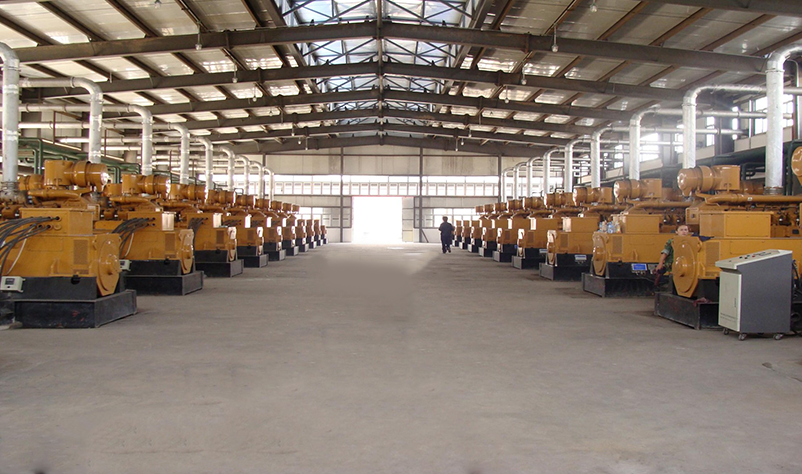沼气发电机组的组成解析:从气体到电能的转化核心
沼气发电机组作为将生物质发酵产生的沼气(主要成分为甲烷,含量 50%-70%)转化为电能的关键装备,通过多系统协同工作实现能量高效转换,整套设备由预处理系统、发动机、发电机、控制系统及辅助设备构成,适配于养殖场、污水处理厂、农业废弃物处理等沼气产出场景,单机组功率覆盖 50kW 至 2000kW,可满足中小规模用电需求或并入公共电网。
As a key equipment for converting biogas (mainly composed of methane, with a content of 50% -70%) produced by biomass fermentation into electrical energy, the biogas generator set achieves efficient energy conversion through multi system collaborative work. The entire equipment consists of a pretreatment system, engine, generator, control system, and auxiliary equipment, suitable for biogas production scenarios such as breeding farms, sewage treatment plants, and agricultural waste treatment. The single unit power covers 50kW to 2000kW, which can meet the electricity needs of small and medium-sized enterprises or be integrated into the public power grid.
沼气预处理系统是保障机组稳定运行的基础,负责净化与调节沼气品质。从发酵罐导出的沼气首先进入气液分离器,去除携带的水分与冷凝液(水分含量需降至 10g/m 以下,否则会腐蚀发动机缸体),分离出的液体回流至发酵系统循环利用。脱硫装置是核心净化单元 —— 沼气中硫化氢含量通常为 100-5000ppm,需通过干法脱硫(如氧化铁吸附)或湿法脱硫(如化学吸收)将其降至 50ppm 以下(高硫会导致发动机机油劣化速度加快 3-5 倍),脱硫剂定期更换(更换周期 1-3 个月,取决于硫化氢浓度)。净化后的沼气进入稳压罐(压力维持在 5-20kPa,波动幅度≤±1kPa),并与空气按比例混合(空燃比 1:10-1:15,根据甲烷浓度动态调整),为发动机提供稳定的混合气(热值偏差≤5%)。
The biogas pretreatment system is the foundation for ensuring the stable operation of the unit, responsible for purifying and regulating the quality of biogas. The biogas exported from the fermentation tank first enters the gas-liquid separator to remove the carried moisture and condensate (the moisture content needs to be reduced to below 10g/m, otherwise it will corrode the engine cylinder), and the separated liquid flows back to the fermentation system for recycling. The desulfurization device is the core purification unit - the hydrogen sulfide content in biogas is usually 100-5000ppm, which needs to be reduced to below 50ppm through dry desulfurization (such as iron oxide adsorption) or wet desulfurization (such as chemical absorption) (high sulfur can accelerate the deterioration rate of engine oil by 3-5 times), and the desulfurizer should be replaced regularly (with a replacement cycle of 1-3 months, depending on the hydrogen sulfide concentration). The purified biogas enters the pressure stabilizing tank (maintained at 5-20kPa with a fluctuation amplitude of ≤± 1kPa) and is mixed with air in proportion (air-fuel ratio 1:10-1:15, dynamically adjusted according to methane concentration) to provide a stable mixture for the engine (calorific value deviation ≤ 5%).

发动机是能量转换的核心部件,将沼气的化学能转化为机械能。混合气经进气管道进入气缸,在活塞压缩至顶点时(压缩比 10-12:1),被高压火花塞点燃(点火电压 20-30kV),发生燃烧反应(火焰传播速度 30-50m/s),瞬间释放热能使缸内温度升至 1800-2200℃,压力达 8-12MPa,推动活塞往复运动。通过曲柄连杆机构,活塞的直线运动转化为曲轴的旋转运动(转速 1500-3000r/min),输出机械扭矩。为适应沼气的低热值特性(通常 18-25MJ/m,仅为天然气的 50%-60%),发动机采用专用缸盖与活塞设计(压缩比高于天然气发动机 2-3 个单位),并配备混合气调节装置 —— 当甲烷浓度下降 10% 时,自动增加进气量(提升 15%-20%),确保输出功率稳定(波动≤±3%)。
The engine is the core component of energy conversion, converting the chemical energy of biogas into mechanical energy. The mixture enters the cylinder through the intake pipe, and when the piston is compressed to its peak (compression ratio of 10-12:1), it is ignited by a high-pressure spark plug (ignition voltage of 20-30kV), causing a combustion reaction (flame propagation speed of 30-50m/s), instantly releasing heat energy to raise the cylinder temperature to 1800-2200 ℃ and pressure to 8-12 MPa, pushing the piston back and forth. Through the crank connecting rod mechanism, the linear motion of the piston is converted into the rotational motion of the crankshaft (at a speed of 1500-3000r/min), outputting mechanical torque. In order to adapt to the low calorific value characteristics of biogas (usually 18-25MJ/m, only 50% -60% of natural gas), the engine adopts a dedicated cylinder head and piston design (compression ratio 2-3 units higher than natural gas engines), and is equipped with a mixture adjustment device - when the methane concentration decreases by 10%, the intake air volume is automatically increased (increased by 15% -20%), ensuring stable output power (fluctuation ≤± 3%).
发电机将机械能转化为电能,实现能源形式的最终转换。发动机曲轴通过联轴器驱动发电机转子旋转(同步转速 1500r/min 对应 50Hz 交流电),转子线圈在定子磁场中切割磁感线,产生三相交流电(电压 400V,频率 50Hz)。小型机组多采用永磁同步发电机(效率 92%-95%),大型机组则使用同步发电机(效率 95%-97%),并配备励磁系统稳定输出电压(电压偏差≤±2%)。发电系统还包含整流与逆变模块(对并网机组而言),将电能转换为符合电网标准的交流电(总谐波畸变率≤5%),满足并网要求或直接供给负载使用。
The generator converts mechanical energy into electrical energy, achieving the final conversion of energy forms. The engine crankshaft drives the generator rotor to rotate through a coupling (synchronous speed of 1500r/min corresponds to 50Hz AC power), and the rotor coil cuts magnetic induction lines in the stator magnetic field, generating three-phase AC power (voltage 400V, frequency 50Hz). Small units often use permanent magnet synchronous generators (efficiency 92% -95%), while large units use synchronous generators (efficiency 95% -97%) and are equipped with excitation systems to stabilize output voltage (voltage deviation ≤± 2%). The power generation system also includes rectifier and inverter modules (for grid connected units), which convert electrical energy into AC power that meets grid standards (total harmonic distortion rate ≤ 5%), meets grid connection requirements, or directly supplies it to the load for use.
控制系统实现全流程自动化运行与安全监控。中央控制器通过传感器实时采集沼气浓度(检测间隔 1 秒,甲烷浓度低于 30% 时停机)、发动机水温(正常 80-90℃,超温时启动冷却风扇)、机油压力(低于 0.2MPa 报警)、发电量等参数,数据传输延迟<0.5 秒。当检测到沼气泄漏(浓度≥0.5%)或设备故障(如超速、超压),系统立即切断进气阀并启动氮气吹扫(吹扫时间 3-5 分钟),同时触发声光报警,确保安全停机(停机响应时间<10 秒)。对多机组联合运行的场景,控制系统可实现负荷分配(各机组负荷偏差≤2%),根据沼气产量自动调整运行台数,避免能源浪费。
The control system achieves full process automation and safety monitoring. The central controller collects real-time parameters such as biogas concentration (detection interval of 1 second, shutdown when methane concentration is below 30%), engine water temperature (normal 80-90 ℃, start cooling fan when overheating), oil pressure (alarm below 0.2MPa), and power generation through sensors, with a data transmission delay of less than 0.5 seconds. When a biogas leak (concentration ≥ 0.5%) or equipment failure (such as overspeed or overpressure) is detected, the system immediately cuts off the intake valve and starts nitrogen purging (purging time 3-5 minutes), while triggering an audible and visual alarm to ensure safe shutdown (shutdown response time<10 seconds). For the scenario of multi unit joint operation, the control system can achieve load distribution (load deviation of each unit ≤ 2%), automatically adjust the number of operating units according to biogas production, and avoid energy waste.
本文由沼气发电机组友情奉献.更多有关的知识请点击://m.gz-yanye.com我们将会对您提出的疑问进行详细的解答,欢迎您登录网站留言.
This article is a friendly contribution from a gas generator set For more information, please click: //m.gz-yanye.com We will provide detailed answers to your questions. You are welcome to log in to our website and leave a message
 在线咨询
在线咨询 官方二维码
官方二维码




 当前位置:
当前位置: 2025.07.24
2025.07.24









